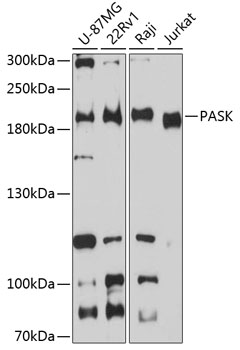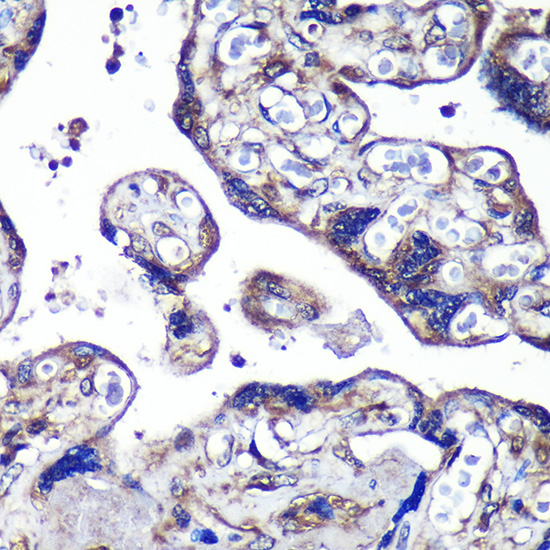Anti-PASK Antibody (CAB8995)
- SKU:
- CAB8995
- Product type:
- Antibody
- Application:
- WB
- Reactivity:
- Human
- Host Species:
- Rabbit
- Isotype:
- IgG
- Research Area:
- Cell Biology
Frequently bought together:
Description
| 抗体名: | Anti-PASK Antibody |
| 抗体コード: | CAB8995 |
| 抗体サイズ: | 20uL, 50uL, 100uL |
| 申し込み: | WB IHC IF |
| 反応性: | Human, Mouse, Rat |
| 宿主種: | Rabbit |
| 免疫原: | Recombinant fusion protein containing a sequence corresponding to amino acids 1194-1323 of human PASK (NP_055963.2). |
| 申し込み: | WB IHC IF |
| 推奨希釈: | WB 1:500 - 1:2000 IHC 1:50 - 1:200 IF 1:50 - 1:200 |
| 反応性: | Human, Mouse, Rat |
| ポジティブサンプル: | U-87MG, 22Rv1, Raji, Jurkat |
| 免疫原: | Recombinant fusion protein containing a sequence corresponding to amino acids 1194-1323 of human PASK (NP_055963.2). |
| 精製方法: | Affinity purification |
| ストレージバッファ: | Store at -20'C. Avoid freeze / thaw cycles. Buffer: PBS with 0.02% sodium azide, 50% glycerol, pH7.3. |
| アイソタイプ: | IgG |
| 順序: | YTLV FEEN PFCE LEET VEAA IHPP YLVS KELM SLVS GLLQ PVPE RRTT LEKL VTDP WVTQ PVNL ADYT WEEV FRVN KPES GVLS AASL EMGN RSLS DVAQ AQEL CGGP VPGE APNG QGCL HPGD PRLL TS |
| 遺伝子ID: | 23178 |
| Uniprot: | Q96RG2 |
| セルラーロケーション: | Cytoplasm, Nucleus |
| 計算された分子量: | 123kDa/142kDa/143kDa |
| 観察された分子量: | 190kDa |
| 同義語: | PASK, PASKIN, STK37 |
| バックグラウンド: | This gene encodes a member of the serine/threonine kinase family that contains two PAS domains. Expression of this gene is regulated by glucose, and the encoded protein plays a role in the regulation of insulin gene expression. Downregulation of this gene may play a role in type 2 diabetes. Alternatively spliced transcript variants encoding multiple isoforms have been observed for this gene. |
| UniProt Protein Function: | PASK: Serine/threonine-protein kinase involved in energy homeostasis and protein translation. Phosphorylates EEF1A1, GYS1, PDX1 and RPS6. Probably plays a role under changing environmental conditions (oxygen, glucose, nutrition), rather than under standard conditions. Acts as a sensor involved in energy homeostasis: regulates glycogen synthase synthesis by mediating phosphorylation of GYS1, leading to GYS1 inactivation. May be involved in glucose-stimulated insulin production in pancreas and regulation of glucagon secretion by glucose in alpha cells; however such data require additional evidences. May play a role in regulation of protein translation by phosphorylating EEF1A1, leading to increase translation efficiency. May also participate to respiratory regulation. Ubiquitously expressed, with slightly higher expression in brain, prostate and testis. Reduced expression was found in placenta. Present in germ cells of testis and in the midpiece of sperm tails. Protein kinase activity is inhibited by the first PAS domain: binding of an unidentified ligand desinhibits the protein kinase activity. May be activated by autophosphorylation on Thr-1161 and Thr-1165 (PubMed:11459942). The activating role of autophosphorylation at Thr-1161 is unclear: according to a report, autophosphorylation at Thr-1161 does not play a major role in activation (PubMed:20943661). Autophosphorylation is enhanced upon phosphatidylinositol monophosphate (phosphatidylinositol 4-phosphate) binding and inhibited upon phosphatidylinositol bi- and tri-phosphate binding. In contrast, phosphorylation of target proteins is inhibited upon all phosphatidylinositol-binding (phosphatidylinositol mono- bi- and tri-phosphate). Belongs to the protein kinase superfamily. CAMK Ser/Thr protein kinase family. 2 isoforms of the human protein are produced by alternative splicing. |
| UniProt Protein Details: | Protein type:Protein kinase, Ser/Thr (non-receptor); Protein kinase, CAMK; Kinase, protein; EC 2.7.11.1; CAMK group; CAMKL family; PASK subfamily Chromosomal Location of Human Ortholog: 2q37.3 Cellular Component: Golgi apparatus; cytoplasm; nucleus Molecular Function:protein serine/threonine kinase activity; signal transducer activity; protein binding; phosphoinositide binding; ATP binding Biological Process: regulation of respiratory gaseous exchange; positive regulation of translation; protein amino acid autophosphorylation; signal transduction; protein amino acid phosphorylation; negative regulation of glycogen biosynthetic process |
| NCBI Summary: | This gene encodes a member of the serine/threonine kinase family that contains two PAS domains. Expression of this gene is regulated by glucose, and the encoded protein plays a role in the regulation of insulin gene expression. Downregulation of this gene may play a role in type 2 diabetes. Alternatively spliced transcript variants encoding multiple isoforms have been observed for this gene. [provided by RefSeq, Nov 2011] |
| UniProt Code: | Q96RG2 |
| NCBI GenInfo Identifier: | 355477262 |
| NCBI Gene ID: | 23178 |
| NCBI Accession: | NP_001239048.1 |
| UniProt Secondary Accession: | Q96RG2,Q05BE4, Q68DY3, Q6GSJ5, Q86XH6, Q99763, Q9UFR7 G5E9F1, |
| UniProt Related Accession: | Q96RG2 |
| Molecular Weight: | 142,929 Da |
| NCBI Full Name: | PAS domain-containing serine/threonine-protein kinase isoform 1 |
| NCBI Synonym Full Names: | PAS domain containing serine/threonine kinase |
| NCBI Official Symbol: | PASK |
| NCBI Official Synonym Symbols: | STK37; PASKIN |
| NCBI Protein Information: | PAS domain-containing serine/threonine-protein kinase; per-arnt-sim (PAS) domain kinase |
| UniProt Protein Name: | PAS domain-containing serine/threonine-protein kinase |
| Protein Family: | PAS domain-containing serine/threonine-protein kinase |
| UniProt Gene Name: | PASK |
| UniProt Entry Name: | PASK_HUMAN |
View AllClose






